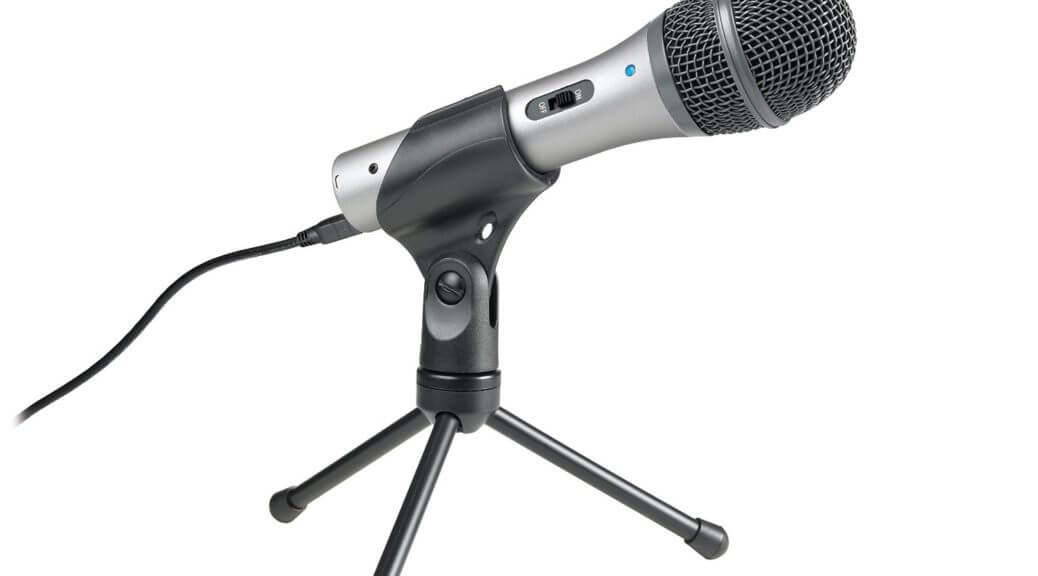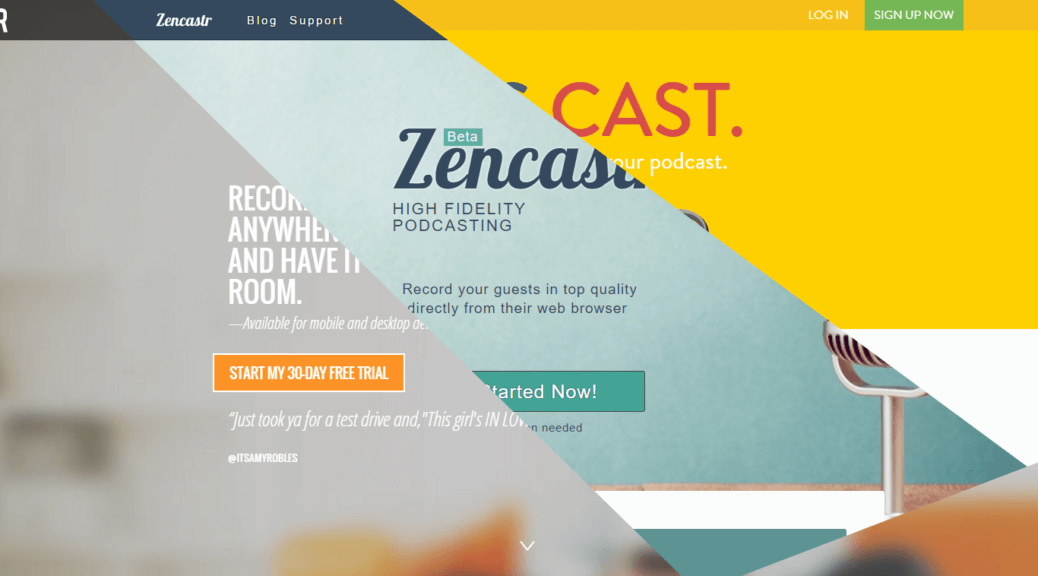
I’ve been asked a few times about my podcasting setup. Since I have done a significant amount of research on podcasting and podcasting equipment, I’ll share that with you here.
Microphones
All podcasters must have a microphone! You could use the one built into your smart phone if you wanted to be really cheap, but ideally you will buy a quality microphone.
The main thing you must decide when buying a microphone is whether you want a dynamic mic or a condenser mic. Dynamic mics pick up only the sound that is directly in front of them, while condenser mics pick up sound in all directions. For the average hobbyist, I strongly recommend a dynamic mic.
What I use: The ATR-2100

 The ATR-2100 is a high-quality dynamic microphone that can take either a USB input or an XLR input. The XLR option is important because it allows you to plug it into high-quality recording equipment! Even if you plan on just recording through your PC at first, the XLR input will give you options later.
The ATR-2100 is a high-quality dynamic microphone that can take either a USB input or an XLR input. The XLR option is important because it allows you to plug it into high-quality recording equipment! Even if you plan on just recording through your PC at first, the XLR input will give you options later.
Since it’s a dynamic mic, it only picks up what’s in front of it. My apartment isn’t a sound studio, but you wouldn’t know it listening to the podcast. Throw one of these babies on it and you’re set.
Some other options:
The Blue Yeti

 The Blue Yeti is very popular among podcasters. It’s a USB condenser mic with very high quality audio.
The Blue Yeti is very popular among podcasters. It’s a USB condenser mic with very high quality audio.
Since it picks up sound in all directions, you need a very quiet place to record. Also, it only has a USB input, so you’re restricted to recording through your PC.
This package on Amazon includes a Blue Yeti along with recording headphones and a pop filter. Not a bad deal for the beginning podcaster!
Headsets
If you’re looking to be really cheap, you could fold your headphone and mic purchases into one by buying a headset. You could get a cheap one like the Sennheiser PC 8, or a more expensive one like the Plantronics Audio 995. Fair warning, no headset will get you the sound quality of a standalone mic.
Headphones
Ideally, you’ll be listening to your audio as you record it so you can notice and fix any problem on the fly. If your headphones allow sound to leak out into your mic, you could be in for some seriously annoying feedback! Also, you want to be able to listen to your podcast in the highest possible quality while editing. That’s why you want some quality, over-the-ear headphones.
What I use: Sennheiser HD 280 Pro Headphones

 The Sennheiser HD 280 Pro is an awesome set of headphones! These block out all outside sound, offer great quality audio, and they’re much cheaper now than they were when I bought them!
The Sennheiser HD 280 Pro is an awesome set of headphones! These block out all outside sound, offer great quality audio, and they’re much cheaper now than they were when I bought them!
The key with recording headphones is to get something that gives you an accurate representation of what you’re listening to. Avoid Beats by Dre, they artificially boost the bass to make music sound better. That means you’ll be hearing something different than your audience, always a bad thing while recording and editing!
Some other options:
Sennheiser offers a cheaper option in the HD 202. Alternatively, you could go with a mid-price option like the ATH-M20x.
Digital Audio Recorders
Computers crash. It’s a sad fact of life. If you record enough podcast episodes through your computer, eventually the software will fail and you’ll lose a whole episode.
A digital audio recorder does one thing: it records sound. It won’t crash on you the way a computer will, because it literally has only one job to do. That’s the primary advantage of recording into a digital audio recorder.
The secondary advantage is that unlike a computer, a digital audio recorder doesn’t have a fan that can turn on and wreck your otherwise-quiet recording area.
What I use: The Zoom H4n (old model)

 I use a (now slightly outdated) Zoom H4n. Remember how I went on about the ATR-2100‘s XLR output earlier? This is what I plug that into. It has two high-quality condenser mics at the top, which I don’t use. However, I can imagine them coming in handy if I was, say, recording a live interview and wanted to get audience reactions and questions. Just point them in the general direction of the audience and go.
I use a (now slightly outdated) Zoom H4n. Remember how I went on about the ATR-2100‘s XLR output earlier? This is what I plug that into. It has two high-quality condenser mics at the top, which I don’t use. However, I can imagine them coming in handy if I was, say, recording a live interview and wanted to get audience reactions and questions. Just point them in the general direction of the audience and go.
 The really nice thing about this is the dual XLR/TRS jacks at the bottom. I plug my mic into the right channel and my phone into the left channel using a 1/8″ to 1/4″ adapter cable like this one.
The really nice thing about this is the dual XLR/TRS jacks at the bottom. I plug my mic into the right channel and my phone into the left channel using a 1/8″ to 1/4″ adapter cable like this one.
That allow me to record myself and my guest onto separate channels. This saves me major headaches in editing! You have no idea how often one person is making a great point just as the other person coughs loudly into his mic. Because I record on separate channels, I can mute the cough. It’s great!
The NEW Zoom H4n Pro

 They made a new edition of the Zoom H4n and it looks slick! I haven’t used it, but it’s the same price as the old one, and Zoom claims it has been improved in every way! Wow!
They made a new edition of the Zoom H4n and it looks slick! I haven’t used it, but it’s the same price as the old one, and Zoom claims it has been improved in every way! Wow!
The main weakness of the H4n I have is weak pre-amps. The new H4n is said to have fixed this problem.
Some other options:
The Zoom H4n is great for my setup, but what if you want something different? For instance, what if you want to plug four ATR-2100s into one recorder and have a four-person panel discussion?
Although the H4n says it’s a four-track recorder, it only has two of those dual XLR/TRS jacks I plug my mic and phone into. The other two tracks can only come in through those built-in condenser mics.
The Zoom H5




 That’s where the Zoom H5 comes in. It’s very similar to the H4n, except that those condenser mics at the top can be switched out for any of a number of alternative inputs. In particular, you can get this Zoom EXH-6 Dual XLR/TRS Capsule that adds an additional two XLR/TRS to the top, just like the bottom ones. If I ever wanted to start a podcast with four people in the same room, that is what I would buy.
That’s where the Zoom H5 comes in. It’s very similar to the H4n, except that those condenser mics at the top can be switched out for any of a number of alternative inputs. In particular, you can get this Zoom EXH-6 Dual XLR/TRS Capsule that adds an additional two XLR/TRS to the top, just like the bottom ones. If I ever wanted to start a podcast with four people in the same room, that is what I would buy.
The H5 also has improved pre-amps over the (old) H4n. That means better quality audio.
The Zoom H6

 Now we’re getting excessive. The Zoom H6 can do everything the H5 can, but it has two more XLR/TRS inputs. If you want to record five or six people, the H6 is for you. It also offers you the ability to edit audio, but I can’t see why you wouldn’t just do that on your computer.
Now we’re getting excessive. The Zoom H6 can do everything the H5 can, but it has two more XLR/TRS inputs. If you want to record five or six people, the H6 is for you. It also offers you the ability to edit audio, but I can’t see why you wouldn’t just do that on your computer.
Conclusion
And you’re set! With a mic, headphones, and a recorder, you can start recording your podcast. Some people add fancy things like mixers and extra pre-amps to their setup, but those things aren’t necessary to making a great podcast with great audio.
[Disclaimer: The links in this article are affiliate links! If you buy through them, I get money.]
The post Podcasting Gear Guide appeared first on The Economics Detective.











